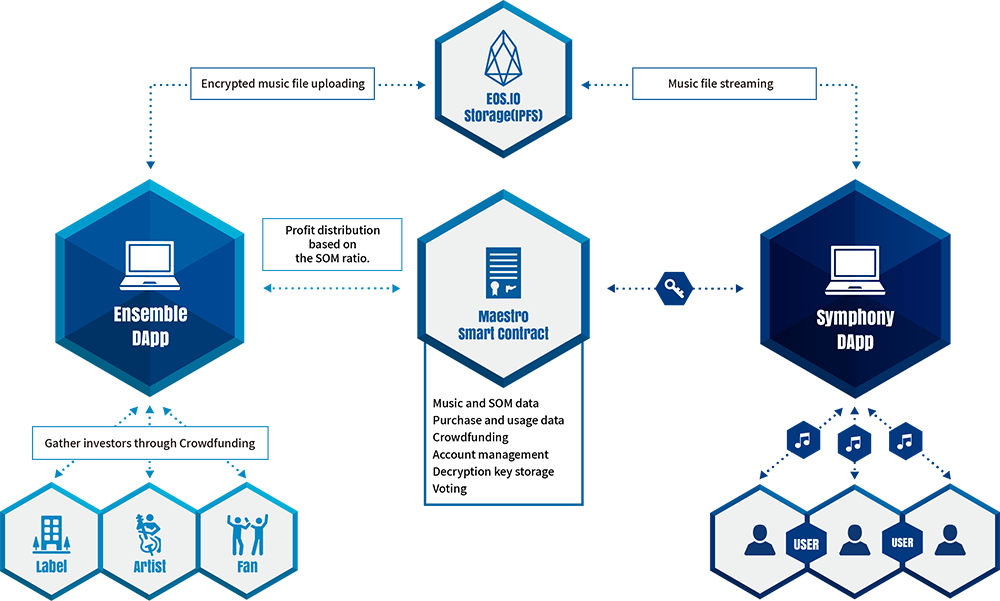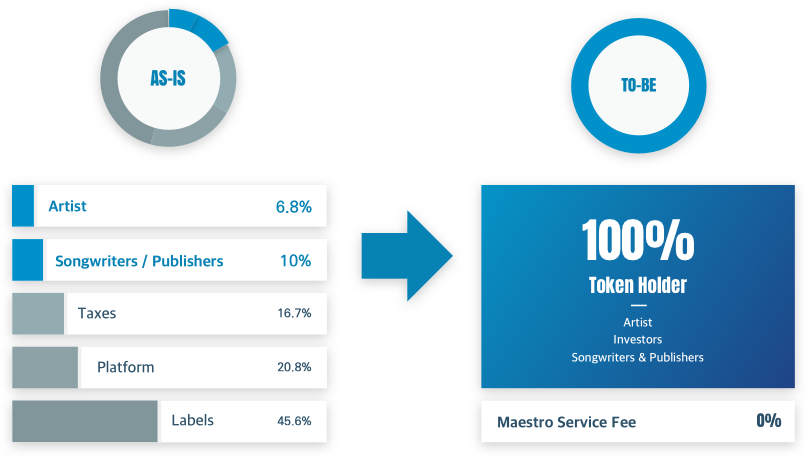
Maestro Project is a blockchain project that brings together musicians and enthusiasts. The project is dominated by artists who get more from their music work, while music lovers pay less.
The Maestro platform, which uses EOS.IO technology in its infrastructure, has two separate branches. One of them is Symphony, a real-time streaming service called streaming service. Ensemble, or community, is a platform for raising funds for artists.
* Maestro Platform *
EOS.IO.-based Blockchain system.
Maestro focuses on the rapid development of software from seamless services to music platforms. Maestro uses EOS-based blockchain technology. We chose EOS.IO because of its high scalability using parallel CPU, far superior speed, and free transactions based on DPOS. To maximize profits for artists and minimize burden for consumers, Maestro uses EOS.IO-based blockchain that does not require individual transaction costs from users. The cost of blockchain is charged to the developer using EOS.IO. There are no fees other than the coins paid to the developer. We use EOS.IO blockchain technology to increase the benefits of decentralization for all users.
Maestro's goal is to decentralize all areas of service. The Maestro team has reviewed the technology for implementing file transmission, streaming, and other functions using a distributed server. The Maestro system will use a distributed server system called IPFS (The InterPlanetary File System) to transmit streaming files. IPFS is a distributed file system that uses a structure to connect computers to the same file system.

IPFS has implemented web-based servers and clients using P2P methods. Previously, the web could only be maintained using a centralized server. With IPFS, the web can be distributed and maintained without a centralized remote server. In other words, even if the server becomes inoperable, the file is distributed through P2P, allowing them to be shared without delay. EOS.IO uses IPFS to implement distributed storage, which is also the reason EOS.IO is selected for Maestro systems. Developers using the EOS platform.IO install a number of coins to ensure CPU and storage usage for blockchain EOS.IO. As Maestro token holder, Maestro allocates the profit generated by its platform to all other token holders.
Maestro is also allocated with a platform advantage based on the number of tokens we hold. Part of this allocated tokens will be used to purchase and store EOS coins to ensure the smooth operation of the Maestro system, which leads to the maintenance and upgrading of quality services. Maestro will further enhance the Maestro system, according to the development stage of EOS.IO.
Maestro's team promises to lead the project efficiently and progressively decentralize service operations. We strive to address the issues or uncertainties found in other music platform projects, and look forward to operating and expanding our operations with practical and rational methods.
If we describe the Symphony section in detail, we can be used as a section where artists showcase their works and their system users. It also provides information about events held and held on the Maestro platform. In this system called Maestro Points (MSP), users can choose likes or dislikes.
Ensemble is a platform for artists to collect the money they ask to create their own work. Here, the users to access them and can adjust the amount of funds as the content of their content.
Maestro platform uses IPFS system. The open source hypermedia display protocol sent by IPFS content and identity. IPFS, which works with devices, performs node systems with the same system files. It takes the need of the website to have a centralized root server that presents the page to the reader. In this way, it is possible to access existing HTTP and design to improve the texture of the internet.
Maestro's goal is to decentralize all areas of service. The Maestro team has used technology to implement file transmissions, streaming, and more using a distributed server. The Maestro system will use a distributed server system called IPFS (The InterPlanetary File System) to transmit streaming files.
IPFS is a distributed file system that uses a structure to connect the same computer files.
IPFS has implemented web based servers and clients using P2P methods. Previously, the web could only use a centralized server. With IPFS, the web can be distributed and maintained without a centralized remote server. In other words, even if the server becomes inoperable, the file is distributed through P2P, allowing them to issue without delay. EOS.IO uses IPFS to implement distributed storage, which is also the reason EOS.IO is selected for Maestro systems.
*Features of the Maestro Project*

The Maestro project has brought some innovations to the music industry. If we explain these briefly, the appeal is as follows:
• First of all, the Maestro platform is not centrally located, so big companies are heavily impacting the hegemony in this area.
• The Maestro project uses EOS blockchain technology. EOS implements a system called horizontal scaling to allow thousands of operations at a time. In other words, when the network demands increase, it connects the server to other servers to meet new requests. So it is a fast and secure system.
• Maestro is profitable on both sides because it has removed the music companies between artists and listeners.
• The process is carried out in full transparency as all transactions are recorded in intelligent contracts.
• The system encourages the appearance of quality products for the performances of the songs by the listeners as performance.
• The system also uses a system called Stake Of Music (SOM) to protect the rights of artists. In the system, the artist can determine the publishing rights of his work as he wishes.
Maestro manages rights for all songs in Ensemble. The rights and ownership details for each song are recorded in the EOS.IO network through smart contracts. User IDs and addresses are linked by syncing with the account management server, and the rights to songs are also synced.
*Mission and Goals*

“To create a productive environment where artists are actively supported, a structure in which the rights of creative works are fairly allocated, and an ecosystem where artists and investors can cooperate to share profits” Maestro’s goal is to change the current centralized management system to a decentralized platform among users with blockchain technology. Ultimately, we want to revolutionize the music streaming industry so that the profits returned to artists and investors are more fairly distributed.

Inevitably, there will be obstacles to implementing new technology in an already mature music industry. New technology must harmonize with the current industry’s structure and has to be accepted by all its stakeholders. Barriers to entry are even higher due to the strong culture and longstanding conventions of the industry. Therefore, Maestro’s team will focus mainly on segments where blockchain technology can be realistically implemented. It must reconcile with the existing bureaucratic music industry to make swift progression.
* About ICO Maestro *
When we look at ico from the Maestro platform, MAE, which has its own token, has a total of 1 billion copies. Of this total, 620 million units were sold. 1 ETH is defined as 10 thousand MAE. While 22 percent of tokens are kept as reserves, 13 percent are confiscated and 3 percent are reserved for prizes. Nearly 500 ETH have been collected during ongoing sales. In the main sales process that began in July, hard hats are set at 6 thousand 200 ETH.

When we look at the roadmap, they plan to enter the stock market in November and are thinking of opening the first demo of the platform. The official opening date for the Maestro platform is May 2019.
* Objectives to Achieve *
Soft cap for ICO: None
Hard cap for ICO: 62,000 ETH
The Maestro team is already under KRW 500 million of funding. Consequently, there is no software, and the project will run regardless of whether we reach the target number or not. After the 2nd ICO, there will be no additional token sales.
* Token *

MAEs are provided via the wallet snapshot in Ensemble. Platform advantage is allocated once per week. The goal of the Maestro team is to decentralize the profit structure through blockchain technology. All platform advantages are affected by the number of MAEs owned. Unsold tokens will be destroyed. Due to inflation, the publishing of additional tokens is expected to occur once per year, and further publication is prohibited as a rule.
* Token Allocation *

Total usage of tokens can be divided into five components: 40% on engineering and software development; 25% on marketing and business development; 15% on operational expenses; and 10% each for license fees and legal expenses.
* Roadmap *

* TIM *






WEBSITE: https: //maestroproject.io/
WHITEPAPER:
https://drive.google.com/file/d/1BNTYyrSiE0mh5Uh0UCWN9Z6SDMRof3gv/view? Usp = share
FACEBOOK: https: //www.facebook.com/rightchainlabs/
TWITTER: https: //twitter.com/MaestroProject1
TELEGRAM: https: //t.me/maestroico
Author (iyanfoursix46): https://bitcointalk.org/index.php?action=profile;u=1061980
My Eth: 0x5ad1153dC8678080f34e0b823d44eC357d403197

Komentar
Posting Komentar